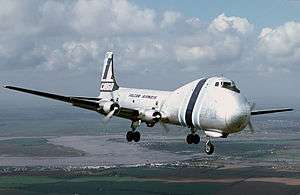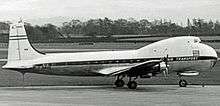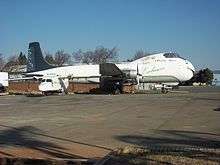Aviation Traders Carvair
The Aviation Traders ATL-98 Carvair was a large transport aircraft powered by four radial engines. It was a Douglas DC-4-based air ferry conversion developed by Freddie Laker's Aviation Traders (Engineering) Limited (ATL), with a capacity generally of 22 passengers in a rear cabin, and five cars loaded in at the front.
| ATL-98 Carvair | |
|---|---|
 | |
| A Falcon Airways Aviation Traders ATL-98 Carvair | |
| Role | Transport |
| Manufacturer | Aviation Traders |
| First flight | 21 June 1961 |
| Introduction | 16 February 1962 with Channel Air Bridge |
| Status | Retired from service |
| Number built | 21 conversions |
| Developed from | Douglas DC-4 |
Design and development
Freddie Laker's idea to convert surplus examples of the Douglas DC-4 and its military counterpart the C-54 Skymaster to carry cars was a relatively inexpensive solution to develop a successor to the rapidly aging and increasingly inadequate Bristol 170 Freighter, the car ferry airlines' mainstay since the late 1940s.[1]
The Bristol Freighter's main drawback was its limited payload, in terms of the number of cars that fitted into a single aircraft. Even the "long-nosed" Mark 32 was able to accommodate only three cars (in addition to 20 passengers). This made carrying cars by air a very tricky business. If a booked car failed to turn up, the flight instantly became unprofitable as a result of the one-third cut in payload. This situation was made worse by the increasing average length of British cars during the 1950s. The average UK car in 1959 was 25 centimetres (9.8 in) longer than in 1950. The extreme seasonality of the car ferry business furthermore resulted in poor aircraft utilization outside peak periods. Moreover, repeated takeoffs and landings on short cross-Channel flights, in turbulent air at lower altitudes with tight turnarounds of as little as 20 minutes, made the aircraft prone to structural fatigue problems. These necessitated rigorous and costly modification programmes, thereby further increasing the type's operating costs on what were essentially low-yield routes.[1]
When the major airlines replaced their obsolete piston airliners with new Boeing 707 and Douglas DC-8 jets on their prestige long-haul routes, the unit price of second-hand DC-4s dropped to as little as £50,000 (equivalent to £1.2 million today). The conversion of each of these airframes into car-passenger carriers cost about £80,000 (£1.9 million today). This was easily affordable by smaller airlines, such as the car ferry companies. Freddie Laker's cardboard model of a converted DC-4 featuring a door in the nose and a flight deck raised above the fuselage had shown that its payload was superior to the Bristol Freighter/Superfreighter. The aircraft was designed to accommodate five average-sized British cars plus 25 passengers as a result of the DC-4's longer and wider fuselage. British Air Ferries (BAF), for example, operated its Carvairs in a flexible configuration, either accommodating five cars and 22 passengers or two-three cars and 55 passengers, permitting it to change over from one configuration to the other in about 40 minutes.[2] In addition, the DC-4's lack of pressurisation made it ideal for low-altitude cross-Channel flights that did not go high enough to require a pressurised cabin. This made the proposed structural conversion straightforward. The result was a new aircraft christened Carvair (derived from car-via-air).[3]
Initially, it was thought that second-hand, pressurised Douglas DC-6 and Douglas DC-7 airframes could be converted into larger, "second generation" Carvairs within 15 years of the original DC-4-based Carvair's entry into service.[4]
The conversion of the original aircraft entailed replacing the forward fuselage with one 8 feet 8 inches (2.64 m) longer, with a raised flightdeck in a bulbous "hump" (akin to the later Boeing 747) to allow a sideways hinged nose door. It also entailed more powerful wheel brakes and an enlarged tail, often thought to be a Douglas DC-7 unit, but actually a completely new design. The engines, four Pratt & Whitney R-2000 Twin Wasps, were unchanged.
The prototype conversion first flew on 21 June 1961. Twenty-one Carvairs were produced in the UK, with production of aircraft 1, 11 and 21 at Southend Airport and the balance at Stansted Airport. The final three aircraft were delivered to Australia's Ansett-ANA, which supplied its own DC-4s to ATL for conversion, unlike the previous 18 aircraft that were purchased by ATL and either sold on or transferred to associate company British United Air Ferries (BUAF). One of the two aircraft still flying in June 2007 was an ex-Ansett airframe. A second Ansett aircraft was abandoned at Phnom Penh in 1975. The first flight of the last conversion, number 21, for Ansett, was on 12 July 1968.
Basic price for a newly converted Carvair in 1960 was £150,000 (equivalent to £3.5 million today), and based on the use of a C54 airframe, whilst only two of the three Ansett airframes supplied were of the DC4 variant.[5]
Operational history

The Carvair was used by Aer Lingus, BUAF and BAF among others, and was used in Congo-Kinshasa during 1960–1964, under contract to the United Nations. Aircraft for Aer Lingus were quickly convertible between 55 seats and 22 seats with five cars. Some aircraft were pure freighters with only nine seats. One aircraft had 55 high-density seats and room for three cars. BAF was the last operator in Europe of the aircraft, keeping them flying into the 1970s.
British United Carvairs made an appearance in the 1964 James Bond movie Goldfinger[6] as Auric Goldfinger and bodyguard Oddjob boarded G-ASDC bound for Switzerland while Goldfinger's Rolls-Royce car was being loaded through the Carvair nose. In the 1967 TV series The Prisoner in the episode "The Chimes of Big Ben", the plane is seen being loaded through the nose, then taking off and landing again.
_1977.jpg)
Accidents and incidents
Of the 21 airframes, eight were destroyed in crashes:
- Rotterdam, Netherlands 1962[7]
- Karachi, Pakistan 1967[8]
- Twin Falls, Canada 1968[9]
- Miami, Florida, United States 1969[10]
- Le Touquet, France 1971[11]
- Venetie, Alaska, United States 1997[12]
- Griffin, Georgia, United States 1997[13]
- McGrath, Alaska, United States 2007[14]
The first of two catastrophic incidents occurred at Karachi on 8 March 1967 when F-BMHU of Compagnie Air Transport (the fourth produced) suffered a double engine failure on take-off and, as a result of the large cargo carried and the rarified atmosphere, the aircraft lost height rapidly and the pilot was forced to make a landing on the National Highway near the airport but struck the Drigh Road railway bridge and several vehicles, killing four of the crew of six plus seven others on the ground. The second catastrophic incident was near Miami, Florida on 23 June 1969 when HI-168 of Dominicana Aviation (the sixteenth produced), after three aborted taxi-outs due to the crew being unhappy with engine performance, finally took off grossly overloaded but suffered again a double engine failure and in trying to return to the airport crashed into a main street east of the airport. When the entire fuel load exploded and caught fire it set fire to many buildings despite the efforts of the 14 fire trucks that attended and took 45 minutes to quell the fire. The four crew and six on the ground were killed, with another 12 on the ground injured.
The accident at Griffin in the United States in April 1997 involved the fifth production Carvair which suffered catastrophic engine failure during the takeoff run and failed to become properly airborne. The aircraft crashed into a vacant Piggly Wiggly supermarket past the airport perimeter, killing both pilots.
Surviving aircraft

The 21st and final Carvair built, 9J-PAA, is in South Africa with Phoebus Apollo Aviation. Formerly registered in Zambia, The aircraft is currently on display at Rand Airport, where it sits near other uncommon aircraft such as the Boeing 747SP. Although now removed from the Zambian register, the owner plans to return it to the skies for air shows.
The second (N89FA / "Miss 1944", the 9th Carvair) is based in Gainesville, Texas at KGLE Gainesville Municipal Airport, and flies with Gator Global Flying Services on ad-hoc cargo charters throughout the United States.
Another Carvair (N898AT, the 20th built) had been airworthy, but was written off after crashing while landing on 30 May 2007 at the airstrip at Nixon Fork Mine in Alaska.[15]
Former operators

- Eastern Provincial Airways[17]
- HawkAir Aviation Services Ltd
- Alisud[18]
- Interocean Airways[16]
- Nationwide Air[17]
- British United Air Ferries and successor British Air Ferries (BAF)[20]
- Channel Air Bridge[16]
- Gator Global Flying Services
- Academy Airlines
- Brooks Fuels
- Falcon Airways[17]
Specifications
Data from Jane's All The World's Aircraft 1965–66[21]
General characteristics
- Crew: 2 or 3
- Capacity:
- Maximum seating 85 passengers or
- five cars and 22 passengers or
- 19,335 lb (8,770 kg) cargo
- Length: 102 ft 7 in (31.27 m)
- Wingspan: 117 ft 6 in (35.81 m)
- Height: 29 ft 10 in (9.09 m)
- Wing area: 1,462 sq ft (135.8 m2)
- Aspect ratio: 9.45:1
- Airfoil: NACA 23016 at root, NACA 23012 at tip
- Empty weight: 41,365 lb (18,763 kg)
- Max takeoff weight: 73,800 lb (33,475 kg)
- Fuel capacity: 2,993 imp gal (3,594 US gal; 13,610 L)
- Powerplant: 4 × Pratt & Whitney R-2000-7M2 Twin Wasp 14-cylinder radial engines, 1,450 hp (1,080 kW) each
- Propellers: 3-bladed Hamilton-Standard Hydromatic, 13 ft 1 in (3.99 m) diameter
Performance
- Maximum speed: 250 mph (400 km/h, 220 kn)
- Cruise speed: 207 mph (333 km/h, 180 kn) at 10,000 ft (3,000 m) (econ. cruise)
- Stall speed: 119 mph (192 km/h, 103 kn) (wheels and flaps up)
- Never exceed speed: 275 mph (443 km/h, 239 kn)
- Range: 2,300 mi (3,700 km, 2,000 nmi) at 10,000 ft (3,000 m) with maximum payload, 3,455 mi (3,002 nmi; 5,560 km) with 10,000 lb (4,500 kg) payload and max fuel
- Service ceiling: 18,700 ft (5,700 m)
- Rate of climb: 650 ft/min (3.3 m/s)
- Takeoff distance to 50 ft (15 m): 4,200 ft (1,300 m)
- Landing distance from 50 ft (15 m): 3,120 ft (950 m)
Notable appearances in media
See also
Related development
Aircraft of comparable role, configuration and era
Notes
- Eglin & Ritchie 1980, pp. 76–77
- Flight International 15 August 1968, p. 249
- Eglin & Ritchie 1980, pp. 77–78
- Whybrow 1959, p. 710
- Flight 18 November 1960, p. 783
- Scott, Jeff (13 January 2002). "Carvair in Goldfinger". aerospaceweb.org. Retrieved 25 August 2017.
- Brouwer, Maarten. "Rotterdam Airport Crash". Aviation Traders Carvair.
- "1967 Database". Aviation Safety Network.
- "1968 Database". Aviation Safety Network.
- "1969 Database". Aviation Safety Network.
- "CRASH OF A AVIATION TRADERS ATL-98 CARVAIR IN LE TOUQUET". Bureau of Aircraft Accidents Archive.
- "National Transportation Safety Board Aviation Accident Final Report Accident Number: ANC97LA093" (PDF). National Transportation Safety Board. 10 November 1998. Retrieved 25 August 2017.
Accident occurred Saturday, June 28, 1997 ... The crew made a successful landing and ran away from the airplane. The airplane continued to burn and was destroyed by fire.
- "1997 Database". Aviation Safety Network.
- "30 May 2007: Carvair N898AT Wrecked". Old Wings.
- "30 May 2007: Carvair N898AT Wrecked". oldwings.nl. 6 June 2007. Retrieved 25 August 2017.
- Vandervord 2018, p. 90
- Vandervord 2018, p. 97
- Vandervord 2018, p. 96
- Green, William (1967). The Observers Basic Book of Aircraft - Civil. London: Fredrick Warbe & Co. Inc. p. 66.
- Vandervord 2018, pp. 94–95
- Taylor 1965, p. 129
References
- "Air Transport: British Air Ferries Look Ahead". Flight International. Vol. 94 no. 3102. 15 August 1968. pp. 248–249. Retrieved 15 March 2019.
- "Commercial Aircraft of the World". Flight. Vol. 78 no. 2697. 18 November 1960. pp. 781–827. Retrieved 15 March 2019.
- Eglin, Roger & Ritchie, Berry (1980). Fly me, I'm Freddie. London, UK: Weidenfeld and Nicolson. ISBN 0-297-77746-7.CS1 maint: ref=harv (link)
- Dean, W. P. & O'Callaghan, M. (2008). The ATL-98 Carvair: A Comprehensive History of the Aircraft and All 21 Airframes. Jefferson, N.C., USA: McFarland & Co. ISBN 978-0-7864-3670-5.CS1 maint: ref=harv (link) (2nd printing)
- Doyle, Paul A. (2000). 'Air Bridge 2' (the design, development and service use of the ATL98 Carvair conversions and their effect on the civilian vehicle air ferry era). Hertfordshire, UK: Forward Airfield Research Publishing. ISBN 09525-624-72.CS1 maint: ref=harv (link)
- Airliner World – Britain's Carferry Airlines, January 2004. Avenel, New Jersey, USA: Key Publishing. (Airliner World online)
- Taylor, John W. R. (1965). Jane's All The World's Aircraft 1965–66. London: Sampson Low, Marston & Company.CS1 maint: ref=harv (link)
- Vandervord, Richard (November 2018). "Database: Aviation Traders Carvair". Aeroplane. Vol. 46 no. 11. pp. 87–100. ISSN 0143-7240.CS1 maint: ref=harv (link)
- Whybrow, D. A. "Bridging That Gap: What Prospects for the Vehicle Air Ferry?". Flight. Vol. 76 no. 2648. pp. 709–711. Retrieved 15 March 2019.CS1 maint: ref=harv (link)
External links
| Wikimedia Commons has media related to Aviation Traders ATL-98 Carvair. |
- Operators’ reference drawing
- Commercial Aircraft of the World Aviation Traders ATL-98 Carvair
- Aviation Traders Ltd.
- The Aviation Traders ATL-98 Carvair
- Aviation Traders Carvair
- DC-4 to Carvair, c/n 42994 history by Gil White
- ATL.98 Carvair N898AT in final stages of restoration
- Douglas DC-4-1009, Carvair ATL-98 Registration: N898AT
- 30 May 2007: Carvair N898AT Wrecked
- ASN Aviation Safety Database Aviation Traders ATL-98 Carvair
- Carvair in Goldfinger